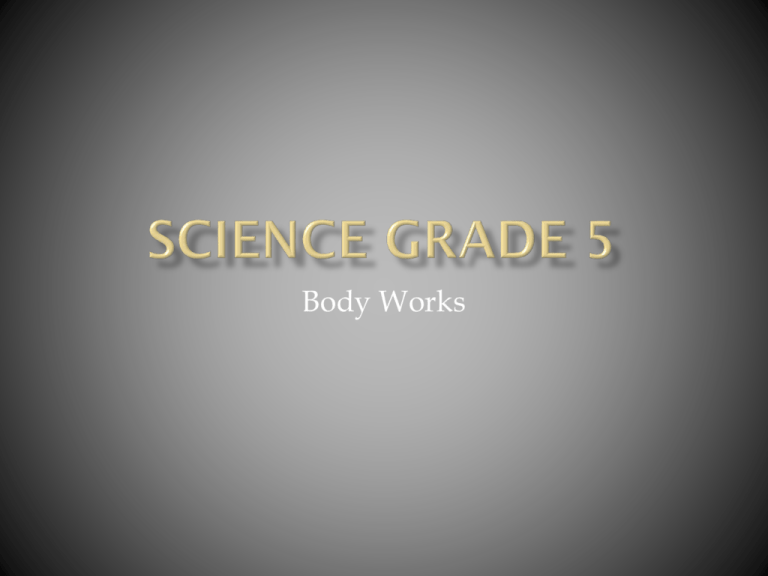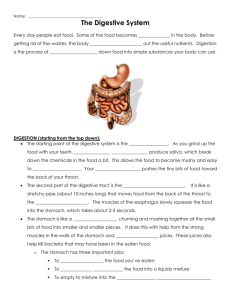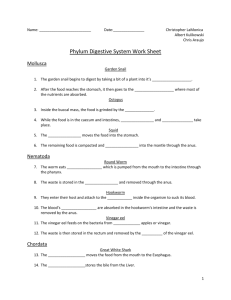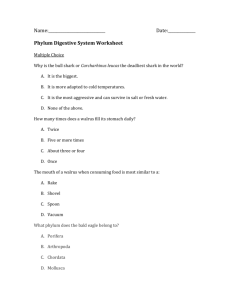Body Works Nutrition and Digestion
advertisement

Body Works Lesson 1 Complete Page 2 in Log Book Pages 6 – 7 What Makes Your Body Live and Grow Define: Cells: the basic building blocks of living tissue. Tissues: groups of cells working together (ex. Muscle tissue) Organs: collections of two or more muscles working together (ex. Heart) Systems: several organs working together to perform a major function (ex. Digestive system) • • • Draw a picture of a body cell and label the nucleus, cytoplasm and cell membrane. Definition and Function: Nucleus: It is the brain of the cell. It controls everything the cell does. Cytoplasm: It is a fluid – like substance that holds all the parts of the cell together and provides nourishment to the cell. Cell Membrane: It is the outside skin of the cell and protects the cell from everything outside. Complete Page 3 and 4 in Log Book Read Pages 8 - 9 5 nutrients you body needs to be healthy: • Carbohydrates Proteins Vitamins Minerals Fats Your body also needs water and fiber. • • • • • • • • 4 ways your body uses the energy it gets from food: To live To grow To be healthy To make and store fat Pages 10 - 11 • • List the 4 food groups and give 5 examples from each. Complete a balanced daily meal plan including breakfast, lunch, dinner and snacks. Make sure to use the recommended amounts from Canada`s Food Guide. Use Page 5 in the Log Book. Pages 12 - 13 • • • • 4 reasons food is processed: To make it edible To make it safe To make it easy to get To make it more appealing List 5 foods that are special to our culture. Complete Page 6 in Log Book. Bell Aliant Learning Centre | Media Player MovieSource: The Digestive System QuizSource: Digestive System Complete Pages 8 and 9 in Log Book. • • • • • Symptoms of food allergies: Upset stomach Rash Swollen lips Diarrhea What happens when a person has a severe allergic reaction and what is used to treat it? Adrenalin Investigate What Happens in your Mouth and Stomach. Complete page 10 in Log Book. • • • Mouth: The teeth grind up the food . The tongue detects “good’ and “bad” flavors and helps move food around the mouth and down the throat. Saliva (spit) helps with chewing and swallowing and starts digestion. Esophagus: A tube-like structure that moves food from the mouth to the stomach. Stomach: A bag- like structure where chemicals break the food down to be used by the body for energy. It has three jobs: to store the food you've eaten to break down the food into a liquidy mixture to slowly empty that liquidy mixture into the small intestine Small intestine: It is a tube - like structure that breaks down the food mixture even more so your body can absorb all the vitamins, minerals, proteins, carbohydrates, and fats. Large Intestine: It is a tube – like structure where nutrients are absorbed. The parts of food that cannot be used are passed out of the body. Pancreas: The pancreas makes juices that help the body digest fats, starches and protein. Liver: A juice from the liver called bile helps to absorb fats into the bloodstream. Gallbladder: The gallbladder serves as a warehouse for bile, storing it until the body needs it. Colon: The part of the large intestine called the colon is where the body gets its last chance to absorb the water and some minerals into the blood. Rectum: The very last stop on the digestive tract. The solid waste stays here until you are ready to go to the bathroom. Anus: When you go to the bathroom, you get rid of the solid waste by pushing it through the anus. Complete Page 11 in Log Book. Diabetes is a disease that affects how the body uses glucose, a sugar that is the body's main source of fuel. Like a CD player needs batteries, your body needs glucose to keep running. If someone has diabetes, the body either can't make insulin (this is called type 1 diabetes) or the insulin doesn't work in the body like it should (this is called type 2 diabetes). The glucose can't get into the cells normally, so the blood sugar level gets too high. Lots of sugar in the blood makes people sick if they don't get treatment. • • • • Kids who have type 1 diabetes can help themselves stay healthy by taking these four very important steps: taking insulin eating a healthy diet and following a meal plan checking blood sugar levels being active by playing and getting exercise • • • Kids who have type 2 diabetes can help themselves stay healthy by taking these three very important steps: getting to a healthy weight (by eating healthy and getting exercise) taking medicine if the doctor feels it's necessary checking blood sugar levels often Study Guide Students should be able to: Define the following terms cells tissues organs diabetes systems Draw a picture of a body cell, label the nucleus, cytoplasm and cell membrane and explain the function of each. List 5 nutrients. List 3 ways the body uses the energy it gets from food. List the 4 food groups and give 3 examples from each. Label a diagram of the digestive system and briefly explain the structure and function of each part. Label with the following parts: mouth, esophagus, stomach, small intestine, large intestine, rectum, anus, liver, gallbladder and pancreas. List 3 ways a person with diabetes can stay healthy.










